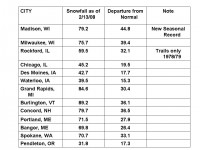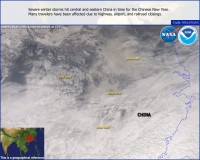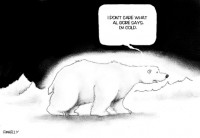Feb 14, 2008
Big Climate’s Strange ‘Science’
By John Atkinson, The Register
Would you trust a software engineer to build a bridge? Climate science is a very, very new field. So new, in fact, that it has had little chance for its assertions to be tested. For example, climate models are being developed with very little ability to test out of sample. Furthermore, the climate science bandwagon has come about solely because of supposed anthropogenic climate change, which means that their funding is intrinsically tied to climate change happening and being man-made. A more self-interested group I could not find anywhere, even looking at the researchers who were paid by big tobacco companies to tell us cigarettes are safe. Of course, astrophysicists and astronomers will happily tell us about global warming on other planets in the solar system, a period of extensive solar activity and the like. But they get poo-pooed just like all the other “real scientists” who have a view. Climate scientists have to disagree with real scientists or they would lose their funding. Finally, why can’t we trust human ingenuity? At the moment, I don’t see that the evidence for anthropogenic climate change is strong enough to wreck our economies to try to change it.
The scientists who interest me in this field are those who can draw on the experience of a lot of people who have come before them. And uniformly in these areas I find scepticism. People who write mathematical models of complex systems for a living tend to find the climate models very unconvincing. Geologists find the arguments very unconvincing. Engineers find the arguments unconvincing. And astrophysicists find the arguments unconvincing. Why? Well the answers are clear: climate groupthink. Read more here.
Feb 13, 2008
The Snowy Areas This Season
By Joseph D’Aleo, CCM
La Ninas are usually snowy across the northern tier and in the north central states. This year has been an excellent example of that. Some areas have already set or are approaching new seasonal records. Some of the snowiest spots this year so far:

See larger table here
Read more on the situation in the Pacific Northwest here. This increase in snow is asociated with the flip of the Pacific Decadal Oscillation and a moderate to strong La Nina. We had written that the lack of snow in the western North America the last few decades related not to global warming as Mote had speculated but to a PDO which since 1979 has favored El Ninos and a more southerly storm track. We warned when the Pacific returned cold, the snow would return with cold temperatures from Alaska to the Northwest and across the northern tier.
While these areas have seen incredible snowfall, other areas like New York City which a few years ago had a stretch of 4 straight years over 40 inches for the first time ever, has seen motly rain or snow changing to rain. Southeastern New England which over 100 inches in places a few years ago has seen mostly bare ground.
Feb 13, 2008
Baliunas Says Global Warming Related To Sun
Tyler Paper
In her lecture series, “Warming Up to the Truth: The Real Story About Climate Change,” astrophysicist Dr. Sallie Baliunas shared her findings Tuesday at the University of Texas at Tyler R. Don Cowan Fine and Performing Arts Center. Dr. Baliunas’ work with fellow Harvard-Smithsonian Center for Astrophysics astronomer Willie Soon suggests global warming is more directly related to solar variability than to increased levels of carbon dioxide in the atmosphere, an alternative view to what’s been widely publicized in the mainstream media.
Her research goes back to time periods when the amount of carbon emission was small enough that it wasn’t a major player. “If you go back far enough you eliminate some of your variables,” she said. “I’ve always been interested with the changes of the sun and how they impact the earth. I decided to look at a narrower time scale this time.” Baliunas asserts that increases and decreases in solar output led to historically warmer and cooler periods. Baliunas said concerns for world energy poverty should be more significant than worrying about something 100 years from now. Read more here.
Dr. Baliunas received her M.A. (1975) and Ph.D. (1980) degrees in Astrophysics from Harvard University. She works with the Harvard-Smithsonian Center for Astrophysics.
Feb 11, 2008
China Loses One-tenth of Forest Resources to Snow Havoc
China View
A total of 17.3 million hectares of forests, about one-tenth of China’s forest resources, have been damaged by the unprecedented snow wreckage, worst in at least five decades, with forests, bamboo and seedlings in some parts of the country seriously destroyed. In its latest report released on Friday, th State Forestry Administration (SFA) confirmed the total losses of forest in 18 provinces in southern China, saying that in the worst-hit region, nearly 90 percent of forests had been ruined. The administration didn’t give any figure for the value of the losses. Previous SFA report showed that by Jan. 31, disastrous winter weather had levied a toll of 16.2 billion yuan (about 2.5 billion U.S. dollars) in China’s forestry sector. See snow photo gallery here.
See satellite view of snow in China courtesy of NOAA OSEI below.

See a high resolution version here.
Feb 07, 2008
Brrrrr. Near-Record Cold Chills Interior Alaska
Newsminer.com
UPDATE: February 8th readings down to -72F at Chicken, just three shy of the February Alaska record. Cold spell longest since 2000. See these NWS Public Information Statements.
The National Weather Service sent out a notice this afternoon reporting some stunningly low temperatures, including an unofficial mark of 70 degrees below zero at Tok at 8 a.m. The last time an official temperature of 70 below or colder was recorded in Alaska came on Jan. 1, 2000, when a reading of 72 below zero was recorded at Chicken, the tiny community on the Taylor Highway in the Fortymile country east of Fairbanks and toward the Canadian border.

The coldest official temperature recorded in the state this morning was 67 below at O’Brien Creek, another spot on the Taylor Highway. Readings of 50 to 60 below zero were common throughout the Interior overnight. Chicken posted a temp of 65 below; Chalkyitsik and Fort Yukon had lows of 60 below; Northway and Beaver, 58 below; Eagle airport, 54 below; Manley, 51 below; Fort Greely, 50 below. Residents of the Fairbanks and North Pole areas also found themselves in the deepening freeze. The Woodsmoke subdivision in North Pole had the coldest temperature in the urban area at 52 below at noon. The noontime temperature at Fairbanks International Airport stood at 45 below. See story here.

See full size cartoon here






